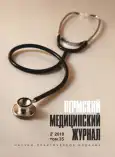Predictors of external pancreatic fistulas development after surgical treatment of infected pancreatonecrosis
- Authors: Kotelnikova L.P.1, Kudryavtsev P.L.2
-
Affiliations:
- Academician Ye.A. Vagner Perm State Medical University
- Perm Regional Clinical Hospital
- Issue: Vol 35, No 2 (2018)
- Pages: 5-10
- Section: Original studies
- URL: https://journals.rcsi.science/PMJ/article/view/9034
- DOI: https://doi.org/10.17816/pmj3525-10
- ID: 9034
Cite item
Full Text
Abstract
Aim. To determine the risk factors for the development of external pancreatic fistulas in the outcome of infected pancreatonecrosis, which do not close as a result of conservative treatment.
Materials and methods. The results of treatment were analyzed in 44 patients with pancreatonecrosis. The influence of different risk factors for the development of external pancreatic fistulas after surgery for infected pancreatonecrosis was studied, using Spearman’s correlation coefficient.
Results. The repeated surgeries one year after pancreatonecrosis were required by 9 % of patients in connection with pancreatic cysts and for 11.36 % – with external pancreatic fistulas. There was observed a positive correlation of a mean value between the formation of external pancreatic fistulas, which did not close after intensive conservative therapy and the localization of necrosis zone in the region of isthmus (r = 0.31, p = 0.00), its depth 50 % and more (r = 0.46, p = 0.00), quantity of outflow (r = 0.55, p = 0.00) with amylase activity > 1000 units (r = 0.53, p = 0.00).
Conclusions. Localization of necrosis zone in the region of isthmus, necrosis depth 50 % and more, quantity of control drainage outflow > 150 ml, high amylase activity in drainage > 1000 units are predictors of the formation of external pancreatic fistulas in the outcome of acute destructive pancreatitis, which need surgical correction.
Keywords
Full Text
##article.viewOnOriginalSite##About the authors
L. P. Kotelnikova
Academician Ye.A. Vagner Perm State Medical University
Author for correspondence.
Email: hir.fpk159@yandex.ru
доктор медицинских наук, профессор, заведующая кафедрой хирургии ФДПО
Russian Federation, 26, Petropavlovskay street, Perm, 614000P. L. Kudryavtsev
Perm Regional Clinical Hospital
Email: hir.fpk159@yandex.ru
врач-хирург второго хирургического отделения
Russian Federation, PermReferences
- Дюжева Т.Г., Шефер А.В., Семененко И.А., Пинский А.Б., Конторщикова Е.С., Джус Е.В., Платонова Л.В., Гальперин Э.И. Наружный панкреатический свищ – отражение многих проблем лечения хронического панкреатита. Материалы пленума правления ассоциации хирургов-гепатологов России и стран СНГ. Ижевск 2012; 23–25.
- Калиев А.А. Анализ летальных исходов больных деструктивной формой острого панкреатита. Современные проблемы науки и образования 2013; 5, available at: https://vivlio phica.com/articles/medicine/263457
- Кригер А.Г., Ахтанин Е.А., Земсков В.М., Горин Д.С., Кармазановский Г.Г., Ветшева Н.Н., Нерестюк Я.И., Калинин Д.В., Глотов А.В. Факторы риска и профилактика послеоперационного панкреатита при резекционных вмешательствах на поджелудочной железе. Хирургия. Журнал им. Н.И. Пирогова 2016; 8: 25–32.
- Коробка В.Л., Шаповалов А.М., Данильчук О.Я., Громыко Р.Е., Коробка Р.В. Варианты хирургического лечения больных хроническим панкреатитом, осложненным панкреатическим свищем. Вестник экспериментальной и клинической хирургии 2012; 2: 423–429.
- Рахимов Р.Р. Комплексный подход к диагностике и лечению инфицированного панкреонекроза. Пермский медицинский журнал 2016; 6: 36–41.
- Beger H.G., Rau B.M. Severe acute pancreatitis: Clinical course and management. World J Gastroenterol 2007; 13 (38): 5043–5051.
- Bassi C., Butturini G., Falconi M., Salvia R., Frigerio I., Pederzoli P. Outcome of open necrosectomy in acute pancreatitis. Pancreatology 2003; 3: 128–132.
- Calu V., Dutu M., Parvuletu R., Miron A. Persistent pancreatic fistula after necrosectomy for severe pancreatitis. Chirurgia 2012; 107(6): 796–801.
- Chen J.Y., Feng J., Wang X.Q., Cai S.W., Dong J.H., Chen Y.L. Risk scoring system and predictor for clinically relevant pancreatic fistula after pancreaticoduodenectomy. World J Surg 2015; 21: 5926–5933.
- Doctor N., Philip S, Gandhi V., Hussain M., Barreto S.G. Analysis of the delayed approach to the management of infected pancreatic necrosis. World J Gastroenterol 2011; 17 (3): 366–371.
- Kannegantia K., Srikakarlapudi S., Acharya B. Successful management of pancreatic ascites with both conservative management and pancreatic duct stenting. Gastroenterology Research 2009; 2(4): 245–247.
- Kozarek R.A., Brandabur J.J., Ball T.J. Endoscopic and interventional therapy of chronic pancreatitis. Gastrointest Endosc 2005; 61950: 568–575.
- Le Bian A., Fuks D., Chopinet S., Gaujoux S., Cesaretti M., Belgaumkar A.P., Smadja C., Gayet B. Consequences of metabolic syndrome on postoperative outcomes after pancreaticoduodenectomy. World J Gastroenterol 2017; 23 (17): 3142–3149.
- Sandrasegaran K., Tann M., Jennings S.G., Maglinte D.D., Peter S.D., Sherman S. Disconnection of the pancreatic duct: an important but overlooked complication of severe acute pancreatitis. Radiographics 2007; 17(5): 1389–1400.
- Sikora S.S., Khare R., Srikanth G., Kumar A., Saxena R., Kapoor V.K. External pancreatic fistula as a sequel to management of acute severe necrotizing pancreatitis. Dig Surgery 2005; 22 (6): 446–451.
- Wen Z., Guo Y., Xu B., Xiao K., Peng T., Peng M. Developing risk prediction models for postoperative pancreatic fistula: a systematic review of methodology and reporting. Indian J Surg 2016; 78 (2): 136–143.
Supplementary files






